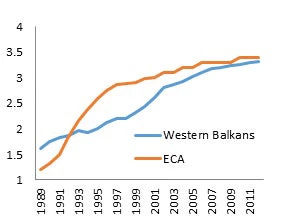The small, open economies of the Western Balkans* are at various stages of progress on three transitions: the transition to market economy, the transition to EU membership, and the transition to high-income status. The first transition started in the 1990s and its ultimate completion will help advance the second. Progress on the second transition, the EU integration, will unleash the EU convergence machine that has seen all but two countries in Europe achieve and sustain high income status. The third transition, overcoming the middle-income trap, remains the most important long-term strategic policy challenge for the Western Balkans. Judged by the past experience of others in Europe and East Asia, even that demanding transition could be achieved in one or two generations.
Progress on the first transition dimension has been the fastest. Strong progress on structural reforms supported by macroeconomic stabilization helped the Western Balkans grow by nearly 5 percent a year on average during 2000-2008. The EBRD transition index for the region – a measure of the progress of countries in transition toward a free market economy – rose from an average of 2.3 in 2000 to 3.2 in 2008. With the 2008-09 economic and financial crisis-induced “new normal” of slower global growth, the rapid expansion of the Western Balkans came to an end: output has expanded by an average of just 1 percent a year since 2009, according to the World Bank’s latest Regular Economic Report on these countries. Employment fell sharply, progress in reducing poverty was halted, and fiscal deficits and debt rose substantially. Much like in many other countries in Europe and Central Asia, progress on structural reforms slowed substantially: EBRD’s transition index has remained little changed for five years. "Stuck in transition" may be a catchy label for the limited progress on structural reforms, as EBRD's 2014 transition report suggested. More appropriately, however, the slowdown suggests the challenges to shifting to new institutions more appropriate for the increased per-capita incomes and as the political determination to advance reforms weakens with slower growth and higher unemployment.
The second transition, to EU membership, began this century and by now four of the Western Balkans countries are EU candidates and the remaining two (Bosnia and Herzegovina and Kosovo) are potential candidates. Only Montenegro has started the accession negotiations with two chapters out of 35 provisionally closed. The map for the transition to the EU is clear – and it has been travelled by 13 countries in Central and Eastern Europe over the last quarter of a century. It is no less demanding, however, given the substantial adjustment needed in many areas, coupled with EU's resolution to admit countries only after governance issues are tackled decisively. The latter requires strengthening particularly of the judiciary and of the other institutions that help ensure a fair playing field for all companies and a decent chance for all citizens. Building these institutions took decades in Western Europe – and that brings us to the third transition.
The third transition, the transition to high-income status, is likely to be the most challenging. If there are any lessons from countries that overcame the proverbial “middle-income trap,” both in Europe and in East Asia, it is that while they paid crucial attention to policies, they diligently created and nurtured institutions. More specifically, it is the institutions that ensure high quality and sustainable accumulation of physical and human capital, and the institutions that provide the environment for economies to shift from imitation to innovation while integrating globally and becoming more inclusive domestically. In other words, the institutions that enable individuals, companies, and regions to be closer together and more productive. In the case of the Western Balkans, such lessons are much clearer given the process of EU integration and the prospect of ultimately being part of the EU convergence machine. Putting that machine into full gear is the opportunity for the Western Balkans to seize. Building and strengthening the institutions for accumulation, integration and inclusion is the key to it.
-------------------------------------------------------------------
| Figure 1. Real GDP growth has weakened (percent change year-on-year) |
Figure 2. Progress on structural reforms has stalled (EBRD transition index)* |
 |
 |
| Sources: National sources and Bank staff calculations and projections. ECA = Europe and Central Asia |
Sources: EBRD. ECA = Europe and Central Asia Note: */ Scale 1-4+, higher means more advanced. |
Progress on the first transition dimension has been the fastest. Strong progress on structural reforms supported by macroeconomic stabilization helped the Western Balkans grow by nearly 5 percent a year on average during 2000-2008. The EBRD transition index for the region – a measure of the progress of countries in transition toward a free market economy – rose from an average of 2.3 in 2000 to 3.2 in 2008. With the 2008-09 economic and financial crisis-induced “new normal” of slower global growth, the rapid expansion of the Western Balkans came to an end: output has expanded by an average of just 1 percent a year since 2009, according to the World Bank’s latest Regular Economic Report on these countries. Employment fell sharply, progress in reducing poverty was halted, and fiscal deficits and debt rose substantially. Much like in many other countries in Europe and Central Asia, progress on structural reforms slowed substantially: EBRD’s transition index has remained little changed for five years. "Stuck in transition" may be a catchy label for the limited progress on structural reforms, as EBRD's 2014 transition report suggested. More appropriately, however, the slowdown suggests the challenges to shifting to new institutions more appropriate for the increased per-capita incomes and as the political determination to advance reforms weakens with slower growth and higher unemployment.
The second transition, to EU membership, began this century and by now four of the Western Balkans countries are EU candidates and the remaining two (Bosnia and Herzegovina and Kosovo) are potential candidates. Only Montenegro has started the accession negotiations with two chapters out of 35 provisionally closed. The map for the transition to the EU is clear – and it has been travelled by 13 countries in Central and Eastern Europe over the last quarter of a century. It is no less demanding, however, given the substantial adjustment needed in many areas, coupled with EU's resolution to admit countries only after governance issues are tackled decisively. The latter requires strengthening particularly of the judiciary and of the other institutions that help ensure a fair playing field for all companies and a decent chance for all citizens. Building these institutions took decades in Western Europe – and that brings us to the third transition.
The third transition, the transition to high-income status, is likely to be the most challenging. If there are any lessons from countries that overcame the proverbial “middle-income trap,” both in Europe and in East Asia, it is that while they paid crucial attention to policies, they diligently created and nurtured institutions. More specifically, it is the institutions that ensure high quality and sustainable accumulation of physical and human capital, and the institutions that provide the environment for economies to shift from imitation to innovation while integrating globally and becoming more inclusive domestically. In other words, the institutions that enable individuals, companies, and regions to be closer together and more productive. In the case of the Western Balkans, such lessons are much clearer given the process of EU integration and the prospect of ultimately being part of the EU convergence machine. Putting that machine into full gear is the opportunity for the Western Balkans to seize. Building and strengthening the institutions for accumulation, integration and inclusion is the key to it.
-------------------------------------------------------------------
*Albania, Bosnia and Herzegovina, Kosovo, FYR Macedonia, Montenegro, and Serbia.


Join the Conversation